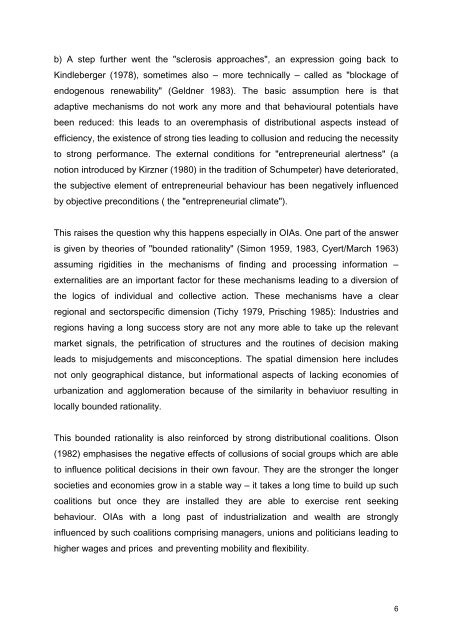Institutional Change in Old Industrial Areas – Lessons for ... - UMAR
Institutional Change in Old Industrial Areas – Lessons for ... - UMAR
Institutional Change in Old Industrial Areas – Lessons for ... - UMAR
Create successful ePaper yourself
Turn your PDF publications into a flip-book with our unique Google optimized e-Paper software.
) A step further went the "sclerosis approaches", an expression go<strong>in</strong>g back to<br />
K<strong>in</strong>dleberger (1978), sometimes also <strong>–</strong> more technically <strong>–</strong> called as "blockage of<br />
endogenous renewability" (Geldner 1983). The basic assumption here is that<br />
adaptive mechanisms do not work any more and that behavioural potentials have<br />
been reduced: this leads to an overemphasis of distributional aspects <strong>in</strong>stead of<br />
efficiency, the existence of strong ties lead<strong>in</strong>g to collusion and reduc<strong>in</strong>g the necessity<br />
to strong per<strong>for</strong>mance. The external conditions <strong>for</strong> "entrepreneurial alertness" (a<br />
notion <strong>in</strong>troduced by Kirzner (1980) <strong>in</strong> the tradition of Schumpeter) have deteriorated,<br />
the subjective element of entrepreneurial behaviour has been negatively <strong>in</strong>fluenced<br />
by objective preconditions ( the "entrepreneurial climate").<br />
This raises the question why this happens especially <strong>in</strong> OIAs. One part of the answer<br />
is given by theories of "bounded rationality" (Simon 1959, 1983, Cyert/March 1963)<br />
assum<strong>in</strong>g rigidities <strong>in</strong> the mechanisms of f<strong>in</strong>d<strong>in</strong>g and process<strong>in</strong>g <strong>in</strong><strong>for</strong>mation <strong>–</strong><br />
externalities are an important factor <strong>for</strong> these mechanisms lead<strong>in</strong>g to a diversion of<br />
the logics of <strong>in</strong>dividual and collective action. These mechanisms have a clear<br />
regional and sectorspecific dimension (Tichy 1979, Prisch<strong>in</strong>g 1985): Industries and<br />
regions hav<strong>in</strong>g a long success story are not any more able to take up the relevant<br />
market signals, the petrification of structures and the rout<strong>in</strong>es of decision mak<strong>in</strong>g<br />
leads to misjudgements and misconceptions. The spatial dimension here <strong>in</strong>cludes<br />
not only geographical distance, but <strong>in</strong><strong>for</strong>mational aspects of lack<strong>in</strong>g economies of<br />
urbanization and agglomeration because of the similarity <strong>in</strong> behaviuor result<strong>in</strong>g <strong>in</strong><br />
locally bounded rationality.<br />
This bounded rationality is also re<strong>in</strong><strong>for</strong>ced by strong distributional coalitions. Olson<br />
(1982) emphasises the negative effects of collusions of social groups which are able<br />
to <strong>in</strong>fluence political decisions <strong>in</strong> their own favour. They are the stronger the longer<br />
societies and economies grow <strong>in</strong> a stable way <strong>–</strong> it takes a long time to build up such<br />
coalitions but once they are <strong>in</strong>stalled they are able to exercise rent seek<strong>in</strong>g<br />
behaviour. OIAs with a long past of <strong>in</strong>dustrialization and wealth are strongly<br />
<strong>in</strong>fluenced by such coalitions compris<strong>in</strong>g managers, unions and politicians lead<strong>in</strong>g to<br />
higher wages and prices and prevent<strong>in</strong>g mobility and flexibility.<br />
6
















